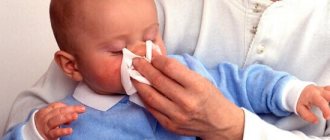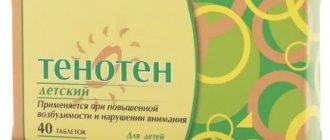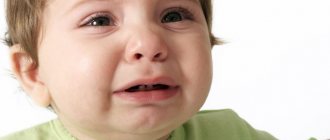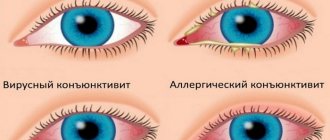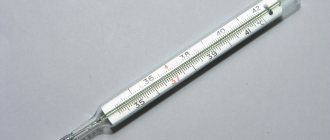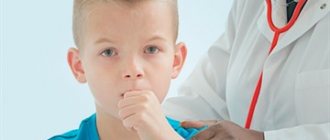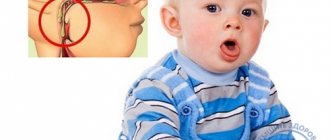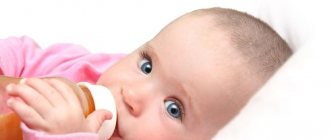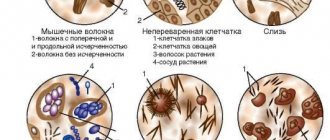What is a runny nose in a baby?
In official medicine, this disease is called rhinitis, and it is characterized by mucus secretions of varying densities and shades from the nasal cavities. They appear if the mucosal membrane is affected by an inflammatory process, mainly generated by exposure to:
- bacterial infections;
- viruses;
- allergens.
Among the causes of a runny nose, a baby may have not only these factors, but also a natural reaction to the environment. The mucous membrane of a newborn is not yet adapted to the air outside the uterus, so it takes time for it to function properly. Additionally, the baby's condition is complicated by the narrow nasal passages and the general sensitivity of the mucous membrane, which can react to any changes in the environment.
Drug treatment
Only a doctor can prescribe safe treatment for a runny nose.
When a runny nose occurs, the nasal passages should be cleared of accumulated mucus. To do this, use an aspirator or syringe with a soft spout.
Medicines for the common cold for infants:
- If there is significant swelling of the nasal mucosa, the doctor may prescribe vasoconstrictor drops: Nazol for small children, Nazivin Baby, etc. The dosage should be measured correctly using a pipette and use for more than 3 days is prohibited. You need to bury the nose once with an interval of 6 hours. These are safe drugs, since the active substance has a low concentration and the effectiveness of the drug does not decrease due to this.
- Drops with an antiseptic effect are used for a runny nose: Protargol, Albucid. These drugs are used to treat bacterial rhinitis. Rhinitis at the initial stage is usually caused by viruses, and then a bacterial infection can be added to the disease.
- Among antiviral agents and immunomodulators, Grippferon, Genferon-light, Viferon suppositories, Derinat are prescribed.
All medications are used only as prescribed by a doctor.
Features of a runny nose in infants
Even with physiological or allergic rhinitis, it is difficult for the child’s body, since already on the first day it leads to swelling of the baby’s mucous membrane, which prevents full breathing, disrupts sleep, and leads to constant crying and loss of appetite. It is possible that the baby will even develop a fever, more due to disruptions of the nervous system than to illness. With viral diseases, the situation is even more difficult, since a newborn’s runny nose is often not only profuse, but also purulent, and the body itself cannot fight the disease.
Symptoms
Physiological runny nose is characterized mainly by the separation of clear mucus from the nasal passages, which is why the baby breathes with difficulty, but he does not suffer from severe nasal congestion, and there is no deterioration in health. If rhinitis in an infant is infectious in nature, the problem should be considered in stages, which differ in symptoms. They look like this:
- The mucous membrane is absolutely (!) dry, there are no problems with nasal breathing, but it can be too noisy, and the baby constantly rubs his nose or sniffs.
- Swelling of the mucous membrane is observed, the baby refuses to eat, becomes restless, may often cry for no reason, and sleeps poorly.
- The density of mucus increases, the nose is stuffy. Purulent discharge (greenish in color) may appear. If the baby is affected by an infection, a cough is added, and the disease may be accompanied by a fever. The frequency of discharge decreases.
Apart from how a runny nose can occur in children if it is not physiological, doctors advise taking into account that different causes of rhinitis also give different manifestations:
- Bacterial rhinitis is characterized by thick yellow or yellow-green discharge, which may be mixed with pus. The temperature rises and falls quickly, but a runny nose will persist for a long time.
- With a viral infection, loss of appetite, lethargy of the baby, and high (38 degrees) temperature that lasts for several hours become a common occurrence. Even with an acute viral infection, there may be no profuse and prolonged runny nose; the mucus is clear and not thick.
Allergic rhinitis in infants
If, with heavy nasal discharge, young parents see an absolutely normal temperature in the child (up to 37.5 degrees), no cold symptoms (cough, thickening of mucus and a yellow or green tint) are observed, there is a high probability that we are talking about allergic rhinitis. It can be triggered by any external factor, but mainly by substances in the atmosphere that irritate the baby’s mucosa. If the cause of the allergy is eliminated, the child’s condition will normalize.
Causes of a runny nose
The inflammatory process of the mucous membrane can be provoked by various causes and conditions. In most cases , the catalysts for a runny nose are waste products of pathological microflora , which are activated by hypothermia or contact with an infected person.
Less commonly, a runny nose is caused by allergens (pollen, dust, animal dander, etc.). To determine the etiology of rhinitis, you need to seek help from a pediatrician, who will tell you how to make breathing easier for a child with a runny nose.
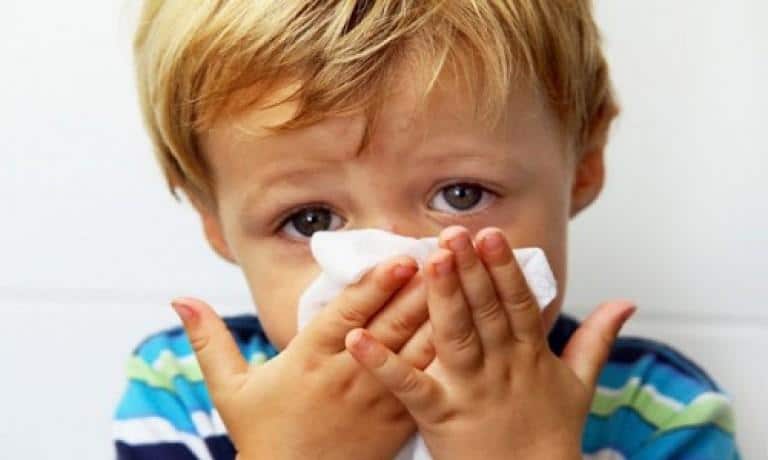
A runny nose in an infant does not always indicate the onset of a respiratory viral disease. Until 3 months of age, babies' nasal mucosa is not fully formed , which causes the appearance of a physiological runny nose.
This phenomenon is not a pathology and does not require medical attention (provided there are no cold symptoms). After the formation of the mucous membrane is complete, the runny nose goes away on its own .
Regardless of the age of the child, rhinitis is accompanied by a whole range of symptoms, including:
- frequent sneezing;
- abundant production of muconasal mucus of various types (from transparent and watery to viscous, yellow-green);
- difficulty breathing and swelling of the mucous membrane;
- cough at night (due to mucus running down the nasopharynx).
Important! Untimely treatment of a runny nose in infants can lead to dire consequences. Due to their age, infants cannot breathe through their mouths, which threatens oxygen starvation and respiratory arrest.
Causes
A runny nose in a baby is not always a sign of a cold, ARVI, etc. As clarified above, this may be a natural moment caused by sensitive mucous membranes that reacted to changes in humidity or air temperature, which will not require medications or therapeutic manipulations. A runny nose can also be caused by a small object entering the nostrils, irritating the lining of the nasal cavity. The intensity of nasal discharge is not related to the cause of its appearance - a less obvious runny nose is possible from bacterial inflammation than from physiological causes.
However, if a baby develops swelling of the mucous membrane or the nose as a whole (noticeable by a change in its size in the area of the bridge of the nose), a runny nose is accompanied by frequent sneezing, or the temperature rises, there is a high probability that among the reasons for its appearance it is worth suspecting:
- allergic reaction (to food, medications, chlorinated water, dust, wool, etc.);
- drying out of the nasal mucosa (accompanied by the formation of crusts, which injure the lining of the nasal passages and provoke bleeding);
- viral or infectious disease (mostly typical for children over 6 months of age);
- bacterial inflammation.
Separately, doctors mention the beginning of the appearance of teeth, which in newborns is accompanied by mucus discharge from the nose due to inflammation of the injured gums. Blood circulation in them and in the lining of the nasal passages is interconnected, which leads to excessive mucus production in the nasopharynx of the baby. There is no need to do anything about this, since such a runny nose goes away on its own when teeth stop cutting.
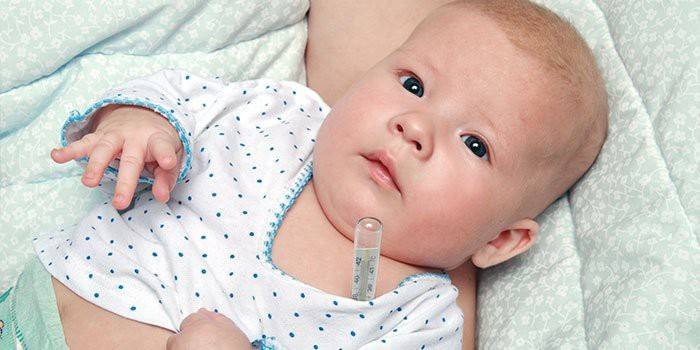
Features of rhinitis in infants under 1 year of age
A runny nose in children has its own characteristics, which complicate treatment. The baby cannot yet clear snot from his nose on his own. As a result of this, a viscous liquid accumulates in the nasopharynx and then contributes to the development of inflammatory processes.
In older children, everything happens much easier, since they can get rid of snot on their own, and, accordingly, it will not penetrate the throat and cause inflammation.
Snot in a baby without fever may have accompanying symptoms:
- heavy breathing, snoring;
- frequent sneezing (1 time does not count);
- the appearance of mucus from the nose (liquid or thick);
- the appearance of crusts in the nose.
Temperature with a runny nose does not always appear, but sometimes it can increase (with acute rhinitis).
Treatment
Most pediatricians agree that you need to understand not how to treat a runny nose in infants, but why it appeared. Rhinitis is always a reaction of the mucous membrane, which cannot be without cause: physiological is characteristic of newborn babies, whose nose is not yet accustomed to the environment. There is no point in treating a baby in such a situation, but leaving the situation “as is” is also not entirely reasonable, since this causes discomfort to the child and parents.
Treatment of a runny nose in infants regarding its prerequisites looks like this:
- with physiological, be sure to wash out the nose, pump out the snot with a “pear” so that there is no congestion and breathing is not impaired;
- in case of allergies, it is important to use drugs that will relieve inflammation from the mucous membranes, and oral administration of antihistamines is possible (you need to consult a doctor);
- in case of a viral infection, especially with a high temperature and severe intoxication, you need to go to an ambulance, or, if the temperature is 37.5 degrees, call a pediatrician at home - here they are sure to prescribe drugs that kill the virus and strengthen the immune system.
What to drip your nose with
Only a doctor can advise medications for a baby, which involve internal administration, if he considers this the only effective way to eliminate rhinitis, and in most situations, pediatricians recommend trying to cope with the problem with nasal drops, which you can do yourself, using breast milk - this is the safest option, which can be used to bury the nose of even a newborn. However, this remedy will not help “break through” congestion - it will only strengthen the immune system.
Mostly doctors:
- use antiseptics (saline solution is the safest for babies);
- vasoconstrictor drops are instilled;
- use nasal immunomodulators;
- moisturizing preparations are injected into the nasal passages.
Moisturizers
Drugs that help save the mucous membrane from drying out (this is especially important for babies aged 2-3 months) are often produced as a spray, which is convenient for irrigating the nasal cavity. In most cases, they are based on a special solution of sea water, which will not provoke allergies. Among the moisturizing drops there are also immune stimulants and anti-inflammatory compounds.
The most effective:
- AquaMaris.
- Aqualor Baby.
Vasoconstrictors
When the runny nose is profuse, the baby’s sleep is disturbed, which negatively affects the state of the nervous system of both the baby and the parents. In this situation, it makes sense to use vasoconstrictor drops, which will stop the secretion of mucus for a short period of time. However, they are used only in the symptomatic treatment of rhinitis, since they do not affect the underlying cause. It is advisable to drip them once a day, at night, since they quickly provoke addiction and dry out the mucous membrane.
For infants (even used for newborns) you can buy:
- Nazol Baby.
- Nazivin 0.01%.
- Otrivin Baby.
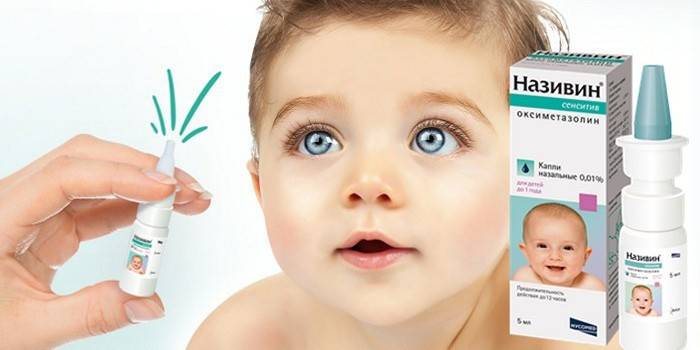
Antiseptic drops
Effective treatment of infectious preconditions for a runny nose should involve the use of drugs that kill viruses (only on the nasal mucosa). However, their choice should be approached with caution: antibiotics are only prescribed by a doctor (they are almost never prescribed for infants) - it is better to focus on less “severe” options. Drops based on colloidal silver and Miramistin perform well. Use must be carried out strictly according to the instructions.
Treatment for children with viral rhinitis often includes:
- Collargol.
- Protargol.
- Octenisept.
Antiviral and immunomodulatory agents
In infants, nasal use is also acceptable for some medications that have the ability to strengthen the body's defenses. The problem with such drugs is that they do not treat chronic diseases, do not provide a quick effect, and therefore do not help during exacerbations: they are mainly used to prevent the onset of the disease. However, if the baby has noticed the first symptoms of a runny nose, the main course of therapy can be supplemented with immunomodulators.
The safest:
- IRS-19.
- Derinat.
Therapeutic measures
As soon as the child has the first symptoms of a runny nose, measures should be taken.
- Do wet cleaning in the room more often.
- Monitor the temperature and humidity in the room.
- If there is no temperature, then it is recommended to be outside. You can go for a walk if the weather is windless and dry.
- Be sure to rinse the child’s nose with saline solutions.
- A special aspirator should be used to remove accumulated mucus.
If a child’s runny nose is accompanied by fever, cough and profuse nasal discharge, then he should not walk outside. Especially when there is frost, rain, wind. You can't bathe your baby.
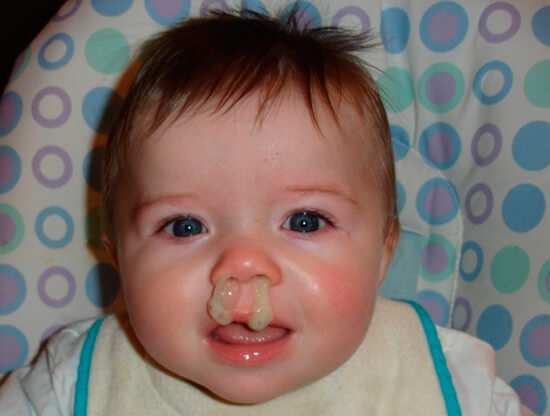
When the baby eats well, is cheerful, there is no cough and the discharge is not intense, walking outside is not only possible, but also necessary.
If there is a need to see a doctor, the following medications may be prescribed:
- antiviral local drops (Grippferon, Interferon);
- vasoconstrictor drops (Nazivin, Otrivin) should not be used for more than three days;
- means that enhance immunity (Derinat drops, Genferon suppositories);
- antiseptic drugs (Miramistin, Albucid, Protargol);
- local antibiotics (Isofra);
- drops based on sea water (Aqua Maris, Aqualor);
- antihistamine nasal drops (Vibrocil);
- antipyretics.
Treatment with folk remedies
If you are afraid of pharmaceutical medications, you can use alternative medicine recipes to eliminate a runny nose:
- Take evening baths (10-15 minutes) using essential oils of eucalyptus and cedar (1-2 drops).
- Fresh onion juice, diluted with warm water (ratio 1:20), is dripped into each nasal passage up to 3 times a day.
- Use a solution of table salt (9 g for 1 liter of water) to rinse the nasal passages of the baby during the day. Doctors say: the composition of this “medicine” is almost the same as in saline solution, so the product is safe.
Chamomile for a runny nose
Pediatricians call chamomile decoction a safe traditional medicine, in which some parents bathe their babies, but it can also be used for inhalation (the procedure should only be carried out if the baby does not have a fever) - this helps to moisturize the mucous membrane and stop the proliferation of microbes. More effective would be rinsing the baby's nasal passages, which can be done 1-2 times a day. Some experts advise making a decoction for oral administration:
- Pour a tablespoon of dried chamomile flowers into 0.5 liters of boiling water.
- Let the liquid boil again and remove from the burner.
- Wrap the container in a towel and leave for an hour.
- Give the child 10 ml of warm liquid in the morning and evening.

Prevention
If you don’t want to hastily figure out how to cure a runny nose in an infant when the problem has worsened, take care to protect the immune system and the nasal mucosa. Doctors give some advice:
- Ensure good air humidity in the apartment (at 65%). A simple method for those who do not have a humidifier is to fill plastic bottles with the neck cut off and place them on the radiators.
- Try to save your child from inhaling tobacco smoke - even a baby with good immunity develops allergies.
- Do wet cleaning regularly.
- Use immunomodulators.
What does Dr. Komarovsky advise?
The famous doctor Komarovsky has his own opinion about the treatment of snot. He recommends following these steps:
- Walk in good weather and the child does not have a fever. This will allow you to train your immune system and nasal mucosa;
- It is important to ventilate the room where the baby is. This must be done 3-5 times a day, and in the summer it is recommended to keep the window open all day (if the weather is good).
- Clean daily. This procedure is especially important during the heating season, since the air in the room is too dry, and wet cleaning will make the air more humid.
- Rinsing the nasal passages with a weak solution of sea or table salt is a preventative measure during colds.
E.O. Komarovsky supports the version that snot, regardless of the cause, does not require treatment, just compliance with preventive measures is enough.
Snot in an infant occurs without fever, both due to illness and for physiological reasons. Treatment is not always required, but you shouldn’t give it a runny nose. Timely help will help get rid of it in a short period of time and will not cause complications.
Article design: Svetlana Ovsyanikova
